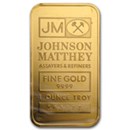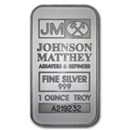
Johnson Matthey History
Johnson Matthey has 200 years of experience in the Precious Metals industry. The mint began in 1817 when Percival Norton Johnson established his Gold assaying business in London. George Matthey joined the company in 1851, officially making it Johnson & Matthey. One year later, the company was appointed to be Official Assayers and Refiners to the Bank of England.
The mint’s dedication to responsible Precious Metal production and interest in technological applications is evident in Johnson Matthey’s history. In 1874, it produced the first standard meter and weights in Platinum-iridium for the International Metric Commission. The next year, they supplied Platinum leads for the first electric lamps. In 1974, the company produced the first catalysts to control vehicle pollution. Then in 1989, Johnson Matthey began commercializing the Platinum-based anticancer drugs it had developed.
Refining History
Johnson Matthey may no longer offer refining services, but it has a long and proud history as one of the UK’s primary refiners. It had a long-standing reputation for integrity and expertise. The refining process Johnson Matthey used was highly complex and involved a profound understanding of Platinum group metal (PGM) science, pyro-metallurgy, multi-stage chemical separations and analytical science. Their Precious Metals refining process involved four major steps:
- Evaluation - An essential step for Precious Metals refining, evaluation involves determining the Precious Metal content of the customer’s material. It allows the refiner to communicate accurately the quantity or value of Precious Metal it will be able to return to the customer.
- Smelting - A pyro-metallurgical process that melts down metal at over 1200 degree Celsius for around 12 hours. In large furnaces, non-metallic components are separated from the desired material. Two types of bullion feed are produced by this process: Silver, which also contains the Platinum and Palladium, and iron, which contains all five types of Precious Metals.
- Chemical Leaching - Once formed, the two different types of bullion undergo multiple leaching processes to concentrate the Precious Metals into solution. Gold and Silver are removed from the Platinum and Palladium.
- Chemical Separation - This multi-stage process separates the five Precious Metals into their final products through solvent extractions, evaporation, dissolution, precipitation and filtration. These processes create the highly porous organometallic salts for each PGM. These salts then undergo heat treatments that transform them into their final PGM, which is then prepared for sale.
With almost two centuries of service in the Precious Metals industry, time has helped shape Johnson Matthey into one of the world’s best-known mints. While it may no longer operate its refining services, Johnson Matthey Gold, Silver and Platinum products are still highly sought after. Consider Johnson Matthey bars if you are interested in making an investment in a brand that offers Precious Metals that are widely recognized and respected around the world.
Learn More About Precious Metals
Buying Precious Metals doesn’t have to be intimidating. Whether you are making a long-term investment or simply admire the beauty of Precious Metals, APMEX provides the tools to help you make the best choice for your portfolio.
See All Articles







